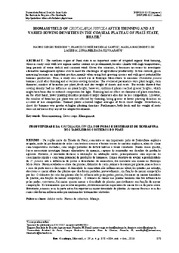Biomass yield of Crotalaria juncea after thinning and at varied sowing densities in the coastal plateau of Piauí State, Brazil.
Biomass yield of Crotalaria juncea after thinning and at varied sowing densities in the coastal plateau of Piauí State, Brazil.
Author(s): TEODORO, M. S.; SANTOS, F. J. de S.; LACERDA, M. N. de; ARAÚJO, L. M. da S.
Summary: The northern region of Piauí state is an important center of irrigated organic fruit farming, wherein sandy soils with low organic matter content are predominant, besides climate with high temperatures, long periods of water deficit and constant wind. Given this situation, it becomes necessary to investigate alternative management options able to meet the challenges of agricultural productivity. In this context, green manuring becomes an important practice, mainly when using fast-growing species and with great potential for biomass production. Thus, a study was carried out at Embrapa Meio-Norte to measure Crotalaria juncea biomass yield after thinning and at various sowing densities. The evaluated parameters were plant height, stem diameter, number of branches per plant, fresh and dry weight of shoots and roots. The results showed that sowing density had no influence on plant height; however, unthinned plants reached greater heights, which might have been due to reduced competition for light. Thinning had no effect on diameters of plant stem base; on the other hand, lower planting densities promoted larger diameters also due to less competition. Likewise, the number of branches per plant was not affected by thinning, being greater at lower planting densities on account of less competition. Thinned plants achieved higher averages of fresh shoot weight. Nevertheless, shoot dry biomass was greater at higher planting densities. Furthermore, both fresh and dry weight of roots were not influenced by any of the adopted treatments.
Publication year: 2016
Types of publication: Journal article
Unit: Embrapa Mid-North
Keywords: Adubo Verde, Cover crops, Crop management, Green manures, Manejo, Planta de Cobertura
Observation
Some of Embrapa's publications are published as ePub files. To read them, use or download one of the following free software options to your computer or mobile device. Android: Google Play Books; IOS: iBooks; Windows and Linux: Calibre.
Access other publications
Access the Agricultural Research Database (BDPA) to consult Embrapa's full library collection and records.
Visit Embrapa Bookstore to purchase books and other publications sold by Embrapa.

